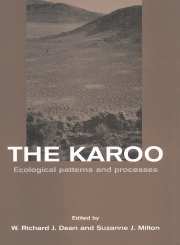Book contents
- Frontmatter
- Contents
- List of contributors
- Foreword
- Preface
- Acknowledgements
- Part one Biogeographic patterns and the driving variables
- Part two Form and function
- Part three Dynamics
- 11 Population level dynamics
- 12 Community patterns and dynamics
- 13 Modelling populations and community dynamics in karoo ecosystems
- 14 Spatially explicit computer simulation models – tools for understanding vegetation dynamics and supporting rangeland management
- Part four Human impacts
- Part five Comparisons
- References
- Index
11 - Population level dynamics
Published online by Cambridge University Press: 23 December 2009
- Frontmatter
- Contents
- List of contributors
- Foreword
- Preface
- Acknowledgements
- Part one Biogeographic patterns and the driving variables
- Part two Form and function
- Part three Dynamics
- 11 Population level dynamics
- 12 Community patterns and dynamics
- 13 Modelling populations and community dynamics in karoo ecosystems
- 14 Spatially explicit computer simulation models – tools for understanding vegetation dynamics and supporting rangeland management
- Part four Human impacts
- Part five Comparisons
- References
- Index
Summary
Introduction
Short-term variability in rainfall patterns in hot and cold deserts is thought to be reflected by fluctuations in population sizes of plants and animals (Caughley and Gunn, 1993). The periodicity of these fluctuations is likely to be tied to mobility and life-histories, and therefore to differ greatly among species.
This chapter reviews the patterns and causes of plant and animal population fluctuations in time and space in the arid zone of southern Africa. Wherever possible, we compare the effects of environmental stochasticity and cyclicity on populations with those of competition, disease and predation. We also consider the possible role of refuges and immigration on the resilience and persistence of small populations in a variable environment. The population dynamics of plants, invertebrates, reptiles, birds and mammals is dealt with separately because the resolution and focus of the information available differs among these groups. In conclusion, we indicate research directions that could improve current predictions based on the few autecological studies and limited long-term data series available for arid zone biota.
Structure and dynamics of plant populations
Ephemerals and annuals
The mass flowering of annual plants in the winter-rainfall western karoo is a major tourist attraction, and the prediction of the flowering time and abundance of annual plants is consequently of economic importance (see Van Rooyen, this volume). Namaqualand ephemerals grew larger and produced more flowers when growing at low temperatures (17 °C) than at higher temperatures (22–27 °C). Moisturestressed plants were smaller than well-watered plants, and allocated less biomass to reproduction (Van Rooyen et al., 1991). Flowering in ephemerals may also be depressed by competition and grazing.
- Type
- Chapter
- Information
- The KarooEcological Patterns and Processes, pp. 183 - 207Publisher: Cambridge University PressPrint publication year: 1999
- 6
- Cited by



